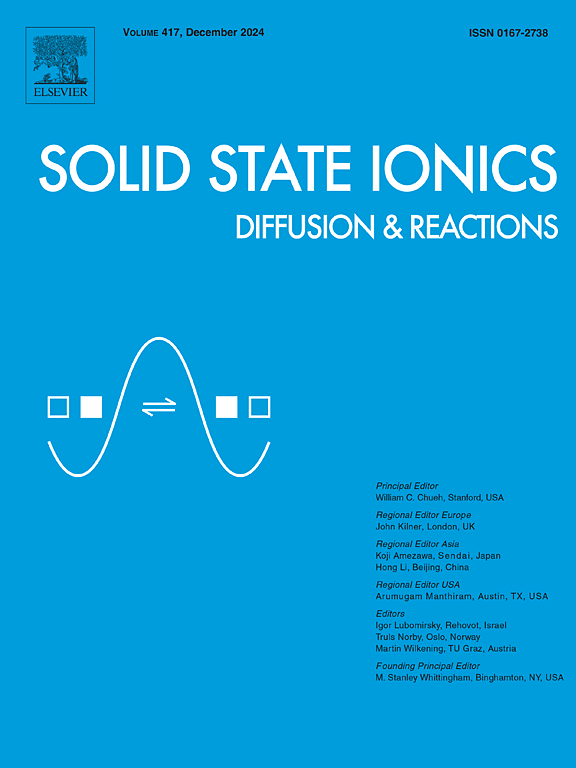Positive impact of the architecture of the oxygen electrode based on LNO and CGO for solid oxide electrochemical cells
IF 3
4区 材料科学
Q3 CHEMISTRY, PHYSICAL
引用次数: 0
Abstract
The Ruddlesden-Popper phase, strontium- and cobalt-free lanthanum nickelate, La2NiO4+δ (LNO), is a mixed-conducting oxide phase and a promising oxygen electrode for SOCs (solid oxide electrochemical cells), thanks to its high diffusion of oxygen and its surface exchange properties. The electrochemical performance is strongly related to the charge transfer at the triple phase boundaries in the surface path and the excorporation/incorporation reaction in the bulk path. In this context, this study explores a strategy to increase the number of active sites in LNO-based electrodes, by designing nanostructured active functional layers and incorporating gadolinium-doped ceria (CGO). Two architectural scenarios are proposed compared to a pure LNO reference: a uniform distribution of CGO in the volume of the LNO and a continuous compositional gradient, both fabricated for the first time by electrostatic spray deposition (ESD).
These designs are investigated based on phase structure, microstructure, elemental chemical composition, and electrochemical properties using SEM-EDS, XRD, and electrochemical impedance spectroscopy. Polarization resistance values are discussed as a function of the distribution of contact points in the electrode volume and LNO crystallization. The results suggest that the presented approach to achieve CGO: LNO-based gradient electrodes allows controlling the localization of the interfaces between the two phases, thereby optimizing charge transfer.

基于LNO和CGO的氧电极结构对固体氧化物电化学电池的积极影响
Ruddlesden-Popper相,不含锶和钴的镍酸镧La2NiO4+δ (LNO),是一种混合导电氧化物相,由于其高氧扩散和表面交换性能,是一种很有前途的固体氧化物电化学电池氧电极。电化学性能与表面路径三相边界处的电荷转移和体路径上的溶出/掺入反应密切相关。在此背景下,本研究通过设计纳米结构的活性功能层并加入掺杂钆的二氧化铈(CGO),探索了一种增加lno基电极活性位点数量的策略。与纯LNO相比,提出了两种结构方案:CGO在LNO体积中的均匀分布和连续的成分梯度,这两种方案都是首次通过静电喷涂沉积(ESD)制备的。利用SEM-EDS、XRD和电化学阻抗谱对这些设计进行了相结构、微观结构、元素化学组成和电化学性能的研究。讨论了极化电阻值作为电极体积中接触点分布和LNO结晶的函数。结果表明,本文提出的方法实现了基于CGO: lno的梯度电极,可以控制两相之间界面的定位,从而优化电荷转移。
本文章由计算机程序翻译,如有差异,请以英文原文为准。
求助全文
约1分钟内获得全文
求助全文
来源期刊

Solid State Ionics
物理-物理:凝聚态物理
CiteScore
6.10
自引率
3.10%
发文量
152
审稿时长
58 days
期刊介绍:
This interdisciplinary journal is devoted to the physics, chemistry and materials science of diffusion, mass transport, and reactivity of solids. The major part of each issue is devoted to articles on:
(i) physics and chemistry of defects in solids;
(ii) reactions in and on solids, e.g. intercalation, corrosion, oxidation, sintering;
(iii) ion transport measurements, mechanisms and theory;
(iv) solid state electrochemistry;
(v) ionically-electronically mixed conducting solids.
Related technological applications are also included, provided their characteristics are interpreted in terms of the basic solid state properties.
Review papers and relevant symposium proceedings are welcome.
 求助内容:
求助内容: 应助结果提醒方式:
应助结果提醒方式:


